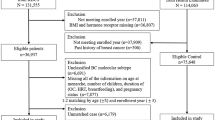Abstract
Purpose
Obesity is associated with tumor promoting pathways related to insulin resistance and chronic low-grade inflammation which have been linked to various disease states, including cancer. Many studies have focused on the relationship between obesity and increased estrogen production, which contributes to the pathogenesis of estrogen receptor-positive breast cancers. The link between obesity and other breast cancer subtypes, such as triple-negative breast cancer (TNBC) and Her2/neu+ (Her2+) breast cancer, is less clear. We hypothesize that obesity may be associated with the pathogenesis of specific breast cancer subtypes resulting in a different subtype distribution than normal weight women.
Methods
A single-institution, retrospective analysis of tumor characteristics of 848 patients diagnosed with primary operable breast cancer between 2000 and 2013 was performed to evaluate the association between BMI and clinical outcome. Patients were grouped based on their BMI at time of diagnosis stratified into three subgroups: normal weight (BMI = 18–24.9), overweight (BMI = 25–29.9), and obese (BMI > 30). The distribution of breast cancer subtypes across the three BMI subgroups was compared.
Results
Obese and overweight women were more likely to present with TNBC and normal weight women with Her2+ breast cancer (p = 0.008).
Conclusions
We demonstrated, for the first time, that breast cancer subtype distribution varied significantly according to BMI status. Our results suggested that obesity might activate molecular pathways other than the well-known obesity/estrogen circuit in the pathogenesis of breast cancer. Future studies are needed to understand the molecular mechanisms that drive the variation in subtype distribution across BMI subgroups.
Similar content being viewed by others
References
Flegal KM, Carroll MD, Kit BK, Ogden CL (2012) Prevalence of obesity and trends in the distribution of body mass index among US adults, 1999–2010. JAMA 307:491–497
Ogden CL, Carroll MD, Kit BK, Flegal KM (2014) Prevalence of childhood and adult obesity in the United States, 2011–2012. JAMA 311:806–814
Lorincz AM, Sukumar S (2006) Molecular links between obesity and breast cancer. Endocr Relat Cancer 13:279–292
Hopkins BD, Goncalves MD, Cantley LC (2016) Obesity and cancer mechanisms: cancer metabolism. J Clin Oncol 34:4277–4283
Jiralerspong S, Goodwin PJ (2016) Obesity and breast cancer prognosis: evidence, challenges, and opportunities. J Clin Oncol 34:4203–4216
Pierobon M, Frankenfeld CL (2013) Obesity as a risk factor for triple-negative breast cancers: a systematic review and meta-analysis. Breast Cancer Res Treat 137:307–314
Perou CM, Sorlie T, Eisen MB, van de Rijn M, Jeffrey SS, Rees CA et al (2000) Molecular portraits of human breast tumours. Nature 406:747–752
Sorlie T, Perou CM, Tibshirani R, Aas T, Geisler S, Johnsen H et al (2001) Gene expression patterns of breast carcinomas distinguish tumor subclasses with clinical implications. Proc Natl Acad Sci U S A. 98:10869–10874
Kohler BA, Sherman RL, Howlader N, Jemal A, Ryerson AB, Henry KA (2015) Annual report to the Nation on the Status of Cancer, 1975–2011, featuring incidence of breast cancer subtypes by race/ethnicity, poverty, and state. J Natl Cancer Inst 107(6):djv048. doi:10.1093/jnci/djv048
Morimoto LM, White E, Chen Z, Chlebowski RT, Hays J, Kuller L et al (2002) Obesity, body size, and risk of postmenopausal breast cancer: the Women’s Health Initiative (United States). Cancer Causes Control 13:741–751
Onitilo AA, Engel JM, Greenlee RT, Mukesh BN (2009) Breast cancer subtypes based on ER/PR and Her2 expression: comparison of clinicopathologic features and survival. Clin Med Res 7:4–13
Carey LA, Perou CM, Livasy CA, Dressler LG, Cowan D, Conway K et al (2006) Race, breast cancer subtypes, and survival in the Carolina Breast Cancer Study. JAMA 295:2492–2502
Calle EE, Kaaks R (2004) Overweight, obesity and cancer: epidemiological evidence and proposed mechanisms. Nat Rev Cancer 4:579–591
Gershuni VM, Ahima RS, Tchou J (2016) Obesity and breast cancer: a complex relationship. Curr Surg Rep 4:1–9
Romond EH, Perez EA, Bryant J, Suman VJ, Geyer CE Jr, Davidson NE et al (2005) Trastuzumab plus adjuvant chemotherapy for operable HER2− positive breast cancer. N Engl J Med 353:1673–1684
Harvie M, Hooper L, Howell AH (2003) Central obesity and breast cancer risk: a systematic review. Obes Rev 4:157–173
Ladoire S, Dalban C, Roche H, Spielmann M, Fumoleau P, Levy C et al (2014) Effect of obesity on disease-free and overall survival in node-positive breast cancer patients in a large French population: a pooled analysis of two randomised trials. Eur J Cancer 50:506–516
Jung SY, Hursting SD, Guindani M, Vitolins MZ, Paskett E, Chang S (2014) Bioavailable insulin-like growth factor-I inversely related to weight gain in postmenopausal women regardless of exogenous estrogen. Cancer Epidemiol Biomark Prev 23:534–544
Rose DP, Vona-Davis L (2010) Interaction between menopausal status and obesity in affecting breast cancer risk. Maturitas 66:33–38
Neuhouser ML, Aragaki AK, Prentice RL, Manson JE, Chlebowski R, Carty CL et al (2015) Overweight, obesity, and postmenopausal invasive breast cancer risk: a secondary analysis of the women’s health initiative randomized clinical trials. JAMA Oncol 1:611–621
Acknowledgements
We would like to thank the Penn Data Store for their assistance in assembling the information used in this study.
Author information
Authors and Affiliations
Corresponding author
Ethics declarations
Conflicts of interest
None.
Rights and permissions
About this article
Cite this article
Gershuni, V., Li, Y.R., Williams, A.D. et al. Breast cancer subtype distribution is different in normal weight, overweight, and obese women. Breast Cancer Res Treat 163, 375–381 (2017). https://doi.org/10.1007/s10549-017-4192-x
Received:
Accepted:
Published:
Issue Date:
DOI: https://doi.org/10.1007/s10549-017-4192-x




